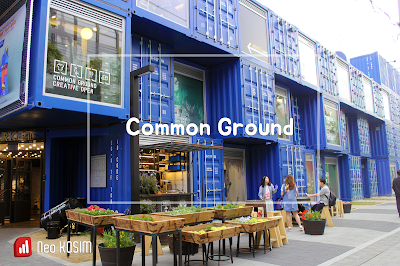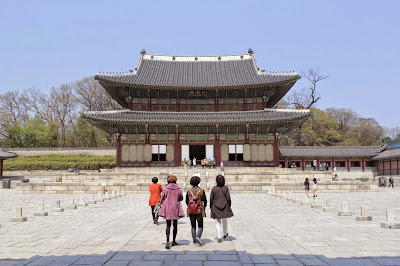Cartier's Contemporary Art Foundation's collection – Highlight - 2017 in Seoul Museum of Art next to Deoksugung Palace, Korea
The way to the Seoul Museum of Art to
walk along the stone wall of the Palace, as for me, is always throb with a
feeling of being quite different from going to another museum.
The stonewall path of old Deoksugung Palace (덕수궁), one of the Five Grand palaces, located next to the city hall and familiar with Korean, on the way to the museum gives a different feeling throughout the four seasons all year round and is beautiful in itself. The shade of trees made by the fresh green seasons, the feeling that when it rains and go this pathway under umbrella, even the raindrops in this place seem to be something different with other places, the stunning colored leaves in the fall, the tiles of the palace covered the white snow in the winter, all of this dazzle the way to the museum. I read an article about the opening of the Cartier collection in the newspaper and visit the museum in the Sunday afternoon.
On the way to the museum, as
usual, people was making their beautiful memories while taking pictures in
front of stone wall as the background. It made me feel better to see the scene.
Fresh performances by Buskers on weekends lead the way to the museum more
romantic combination. But to be wonder, I don't know why there is a popular
myth handed down for a long time that if you walk on this stonewall walkway with lover, you will
surely break up. Of course, many lovers were walking this way when I visited there looked as
if they didn’t mind at all what it does.
Large roses were welcome me at the museum entrance. It’s the artwork with the name ”Rosy Life( La Vie en Rose)". This bold, huge rose bouquet made of FRP (Fiber reinforced plastics) material always welcomes me as usual like an old friend. I breathed in the utmost the air of museum as sat on a stone chair, as always, before entering the museum. The name of this stone chairs art is 'communication'.
I had a feeling that it was very familiar to me and
comfortable each time whenever I visited. While searching for museum
information to write this blog, I realized that this is also an artwork.
As I looked at the right side of the entrance door, a knight in a shiny silver armor was situated above eye level. I thought there was some consistency in artworks because the company supports this art foundation is doing business related to jewelry, so I was slightly worried for a moment that other works might have the same tendency. However, it was my perfect groundless anxiety. I lined up a line to join and it didn't take a long time to enter. It was able to appreciate for me it comfortably during the time because the staffs adjust the number of audience at a distance of time. I am not an expert in art, so I don’t like to see lots of artwork in a short time. To be sorry for the artists but I am just ordinary person. I am impressed at first, however as I go backwards, I become dull. So, I prefer the exhibition style not the dense exhibition form but a little far away spacing arrangement. In that sense, this exhibition gave me very comfortable moving line. Nevertheless, the level of the exhibits was so great and valuable that I continued to fill my curiosity with diverse art world.
The stonewall path of old Deoksugung Palace (덕수궁), one of the Five Grand palaces, located next to the city hall and familiar with Korean, on the way to the museum gives a different feeling throughout the four seasons all year round and is beautiful in itself. The shade of trees made by the fresh green seasons, the feeling that when it rains and go this pathway under umbrella, even the raindrops in this place seem to be something different with other places, the stunning colored leaves in the fall, the tiles of the palace covered the white snow in the winter, all of this dazzle the way to the museum. I read an article about the opening of the Cartier collection in the newspaper and visit the museum in the Sunday afternoon.
Large roses were welcome me at the museum entrance. It’s the artwork with the name ”Rosy Life( La Vie en Rose)". This bold, huge rose bouquet made of FRP (Fiber reinforced plastics) material always welcomes me as usual like an old friend. I breathed in the utmost the air of museum as sat on a stone chair, as always, before entering the museum. The name of this stone chairs art is 'communication'.
As I looked at the right side of the entrance door, a knight in a shiny silver armor was situated above eye level. I thought there was some consistency in artworks because the company supports this art foundation is doing business related to jewelry, so I was slightly worried for a moment that other works might have the same tendency. However, it was my perfect groundless anxiety. I lined up a line to join and it didn't take a long time to enter. It was able to appreciate for me it comfortably during the time because the staffs adjust the number of audience at a distance of time. I am not an expert in art, so I don’t like to see lots of artwork in a short time. To be sorry for the artists but I am just ordinary person. I am impressed at first, however as I go backwards, I become dull. So, I prefer the exhibition style not the dense exhibition form but a little far away spacing arrangement. In that sense, this exhibition gave me very comfortable moving line. Nevertheless, the level of the exhibits was so great and valuable that I continued to fill my curiosity with diverse art world.
 |
| "In BED" by Ron Mueck Oh, my. Awesome. He was lying in bed and resting so naturally. |
 |
| What his eyes say is .... |
I read in the newspaper that the foundation would just support the
artists but not interfere with the works of them. It seemed like that they are
trying to take the high road. Well, how lucky we are to see these works for
free! In addition, there was no limit for visitors to take a photo so they easily took pictures from various angles.
It was a great day for the art museum outing in a long time. I'd like to recommend not to miss this wonderful art world. It is now your turn for what you will see and feel. Be there and breathe in the air of art, please.
It was a great day for the art museum outing in a long time. I'd like to recommend not to miss this wonderful art world. It is now your turn for what you will see and feel. Be there and breathe in the air of art, please.
Cartier's Contemporary Art Foundation's
collection <Highlight>
In where: At the Seoul Museum of Art(SeMA,
서울시립미술관) 1-3F,
Duration: May 30 ~August 15, 2017.
How to get: Seoul city hall station (Subway
line 1 or line 2) exit#2
. . Walk along the Duksugung Palace(덕수궁) stonewall walkway
. . in 5~10 minutes.
Admission fee: Free






































































